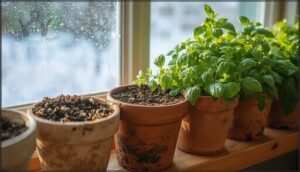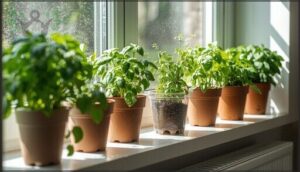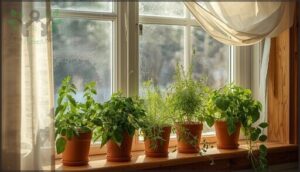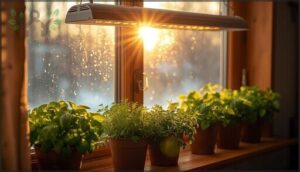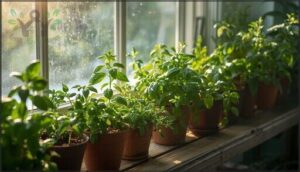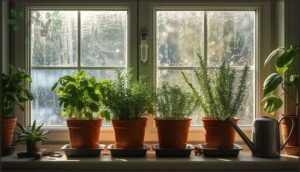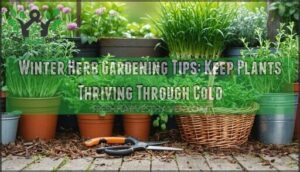This site is supported by our readers. We may earn a commission, at no cost to you, if you purchase through links.
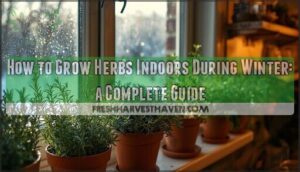
Your summer basil plant doesn’t have to become a sad memory when frost arrives. While outdoor gardens go dormant, hardy herbs like rosemary, sage, and thyme can flourish on your windowsill through winter—sometimes growing even better than they did outside.
The secret isn’t complicated: these cold-weather champions naturally slow down during shorter days, meaning they’ll forgive you for underwatering and won’t sulk in cooler rooms. With the right containers, proper drainage, and a few smart tricks for managing light, you can snip fresh herbs for your cooking all season long.
Whether you’re working with a sunny south-facing window or supplementing with grow lights, indoor herb gardening during winter transforms your kitchen into a year-round harvest zone.
Table Of Contents
- Key Takeaways
- Best Herbs to Grow Indoors in Winter
- Setting Up Your Indoor Herb Garden
- Providing Light and Temperature for Herbs
- Planting and Propagating Herbs Indoors
- Winter Care and Maintenance Tips
- Frequently Asked Questions (FAQs)
- Can you grow herbs indoors during winter?
- What herbs are easiest to grow indoors in winter?
- What to do with potted herbs in winter?
- Can I grow parsley indoors in winter?
- What to do with my herb garden in the winter?
- Can you grow oregano indoors in winter?
- Can you leave potted herbs outside in winter?
- Can herbs be grown hydroponically indoors?
- What are the best herbs for beginners?
- How do I store excess harvested herbs?
- Conclusion
Key Takeaways
- Hardy herbs like rosemary, sage, and thyme actually thrive indoors during winter because they naturally slow down in shorter days, making them more forgiving of underwatering and cooler temperatures than summer herbs.
- You don’t need perfect sunlight—herbs like mint, parsley, and chives will keep producing with just 3-5 hours of indirect light daily, though adding grow lights 12-18 inches above plants for 14-16 hours helps fill the gap.
- Overwatering kills more indoor herbs than anything else in winter, so stick your finger an inch deep into the soil and only water when it feels dry, typically just once or twice weekly.
- Starting herbs from cuttings is faster and easier than seeds for most varieties—soft-stemmed herbs like mint root in water within two weeks, while woody types like rosemary prefer moist soil with rooting hormone.
Best Herbs to Grow Indoors in Winter
Not all herbs thrive equally well indoors during winter—some handle low light better, while others are practically made for year-round growing inside. The good news is that you’ve got plenty of options, no matter what your space looks like or where you live.
Let’s look at the herbs that’ll actually do well in your home this season.
Hardy Herbs for Winter Conditions
Some herbs are built for winter—they’re your reliable friends when temperatures drop. Cold-hardy varieties like rosemary, sage, thyme, and chives can genuinely overwinter indoors with proper care. Here’s what makes them special:
- They enter winter dormancy naturally, requiring less water and cooler conditions (around 10–21°C)
- Their frost tolerance means they’ll survive brief temperature dips without dying back
- Perennial herbs develop deep root systems that access warmer soil layers
- Indoor acclimation happens smoothly since they’re adapted to cold weather transitions
These tough plants thrive when you respect their seasonal rhythm. Rosemary, for example, is known for its medicinal properties.
Herbs for Low Light Environments
Not every spot in your home gets full sun, and that’s perfectly fine. Light-tolerant species like mint, parsley, chives, and cilantro thrive in partial shade—they’ll keep producing even with just 3–5 hours of indirect light daily. If your space is dimmer, supplemental lighting helps prevent leggy growth and pale leaves. To guarantee the best results, consider that indoor gardening saves money compared to buying herbs at the store.
Here’s what these shade-tolerant herbs can handle:
| Herb | Natural Light Need | With Grow Lights |
|---|---|---|
| Mint | 3–4 hours indirect | 10–12 hours daily |
| Parsley | 100–200 PPFD | 12–14 hours daily |
| Chives | East/north windows | 10–12 hours daily |
Cultural practices matter: use well-draining soil, rotate pots weekly, and watch for overwatering risks—reduced light means slower evaporation and root problems.
Culinary Herbs Ideal for Indoor Use
Now that you’ve got the shade situation handled, let’s talk about what actually grows well on your kitchen counter. Basil brings bold flavor and thrives with bright light—expect harvestable yields within weeks. Parsley varieties like Italian flat-leaf offer stronger taste than curly types and tolerate cooler temps.
Chives regrow continuously after pruning, mint propagation is nearly foolproof, and thyme yields stay consistent through winter. These culinary herbs reward you with fresh harvests indoors.
Choosing Herbs by Planting Zone
Your planting zone tells you what survives your winters outdoors—and what doesn’t. In Zones 3–5, rosemary and lavender need indoor protection since freezes drop below −30°F.
Zones 6–7 offer flexibility: hardy herbs like sage and thyme withstand cold with mulch, while tender perennials move indoors.
Zones 8+ keep Mediterranean herbs thriving outside year-round. Match your regional herb choices to local temperatures, and you’ll harvest fresh all winter long.
Setting Up Your Indoor Herb Garden
Growing herbs indoors in winter isn’t complicated, but getting the setup right makes all the difference. You’ll need to think about three key things: what you’re growing them in, how water moves through your pots, and where you actually place them in your home.
Let’s walk through each of these so your herbs have everything they need to thrive.
Selecting Containers and Potting Mix
Your container choice matters more than you’d think. Grab pots between 6 to 12 inches in diameter—they’re the sweet spot for root growth. Drainage holes are non-negotiable; 92% of experts won’t skip them.
For potting mix, blend one-third potting soil, one-third organic matter, and one-third perlite to nail that 6.2–7.0 pH range most herbs love. Sterile, bagged mixes beat reused soil by a landslide, cutting disease risk by 80%.
Ceramic breathes well, but plastic retains moisture longer—pick what fits your style.
Ensuring Proper Drainage and Air Circulation
Without proper drainage and airflow, your indoor herbs won’t stand a chance. Make sure your pots have at least one drainage hole at the bottom—multiple holes for larger containers prevent waterlogged roots and root rot. Pair that with gentle airflow around your plants; aim for a soft breeze that keeps humidity in check without stressing foliage.
Think of it like giving your herbs room to breathe. Good ventilation systems and well-draining soil work together to keep disease away.
Choosing The Best Indoor Location
Finding the right spot for your herbs makes all the difference. Here’s what to prioritize:
- South-facing windows deliver up to 30% more light than other directions—your herbs will thank you with 22% more leaf growth.
- Keep them 6+ inches away from cold windows and heat sources like radiators to prevent damage.
- Aim for 65–70°F daytime temperatures and maintain good air circulation without direct drafts.
- Group plants together to boost humidity naturally during dry winter months.
Location consistency beats ideal every time.
Providing Light and Temperature for Herbs
Light and temperature are the two things that matter most when you’re growing herbs indoors during winter. Without enough of each, your plants will struggle no matter how well you care for them otherwise.
Let’s walk through how to get both of these right in your space.
Maximizing Natural Sunlight Indoors
Your south-facing windows are your best friend during winter—they’ll give your herbs 6 to 8 hours of direct light daily, far better than east or west-facing spots. Position plants within 12 inches of the glass to catch maximum sunlight intensity.
Here’s the trick: rotate your pots every few days so leaves get even exposure, and use white-painted sills to reflect extra light. These small adjustments make a real difference when natural light is scarce.
Using Grow Lights Effectively
Ready to level up your herb game? Grow lights are your winter secret weapon when natural sunlight falls short. LED fixtures deliver greater energy efficiency—roughly 53% more photosynthetic photons than fluorescent options—making them cost-effective.
Position lights 12–18 inches above your herb canopy, running them 14–16 hours daily to match outdoor conditions. Full-spectrum white LEDs work best, delivering the blue and red wavelengths your herbs need for compact, flavorful growth year-round.
Maintaining Optimal Temperature and Humidity
Think of temperature and humidity as your herb garden’s comfort zone—get them right, and your plants reward you with vigorous growth. Most indoor herbs thrive between 65–75°F during the day and 55–65°F at night, with humidity levels around 40–60%.
- Sudden temperature swings above 15°F in 24 hours can trigger growth defects and leaf damage
- Dry indoor air from heating causes leaf desiccation—group pots together on pebble trays to boost humidity
- Digital thermometers and hygrometers track environmental stressors, helping you catch fluctuations before they harm your plants
Stable conditions mean faster growth and healthier harvests.
Planting and Propagating Herbs Indoors
Now that you’ve got the right light and temperature locked in, it’s time to actually get your herbs in the ground—or in your indoor space. You have three solid ways to start: growing from seeds, bringing outdoor plants inside, or taking cuttings from plants you already have.
Let’s walk through each method so you can pick what works best for your situation.
Starting Herbs From Seeds
Starting herbs from seed indoors gives you complete control over germination rates and growth conditions. Choose fast-sprouting varieties like basil (3–6 days) or cilantro (6–8 days) for quick wins.
Maintain daytime temperatures between 60–70°F and humidity above 75% using a dome. Use quality potting mix with excellent drainage. Most seeds need 12–14 hours of light daily.
With proper temperature control and humidity levels, you’ll see seed viability rates exceed 60%—often 70% indoors. Start slow-germinators like parsley and rosemary in January for spring success.
Transplanting Outdoor Herbs Inside
Moving outdoor herbs indoors before frost hits is your best shot at overwintering them successfully. Timing matters—transplant when temperatures drop below 40°F. Here’s how to set your herbs up for winter survival:
- Inspect roots carefully and rinse away outdoor soil
- Use sterile potting mix in containers with drainage holes
- Place transplants in indirect light for 2–3 weeks
- Maintain 65–75°F with 40–60% humidity
- Water when soil surface feels dry, never soggy
This acclimation process cuts leaf drop by 40% and boosts survival rates considerably.
Propagating Herbs From Cuttings
Now that your transplants are settled, try propagating cuttings from healthy stems—it’s your ticket to endless herbs. Snip 4- to 6-inch pieces and remove lower leaves to prevent rot. Rooting hormones boost success rates dramatically, cutting your rooting time nearly in half.
Keep cuttings warm (65–75°F), humid, and under indirect light. Soft-stemmed herbs like mint root in water within two weeks, while woody types like rosemary prefer moist soil. Avoid overwatering—it’s the silent killer of new roots.
Winter Care and Maintenance Tips
Now that your herbs are planted and settling in, the real work of keeping them healthy through winter begins. Winter isn’t just about surviving—it’s about giving your herbs the right care so they actually thrive and give you plenty to harvest.
Let’s walk through the key maintenance steps that’ll keep your indoor herb garden in top shape.
Watering and Moisture Management
Overwatering is the fastest way to kill indoor herbs—so here’s the real secret: check your soil before you water. Stick your finger about an inch deep; if it feels dry, water thoroughly until it drains from the bottom. During winter, most herbs need watering just once or twice weekly since they’re growing slower.
The fastest way to kill indoor herbs is overwatering—check soil an inch deep before watering, and water only when dry
Watch for these game-changers too: humidity around 40-60% keeps leaves healthy, good drainage prevents root rot, and cooler temperatures (65-75°F) naturally reduce how thirsty your plants get.
Pruning and Harvesting Techniques
With the right pruning approach, your indoor herbs can practically double their yield. Here’s what works: prune every 2–3 weeks during winter, snipping just above leaf nodes to trigger bushier growth. Remove no more than 75% of current growth at once—think of it like coaxing your plants to branch rather than stripping them bare.
- Prune early morning for best oil concentration
- Use sharp, sanitized scissors to prevent disease
- Harvest outer leaves first, leaving inner growth intact
- Space pruning sessions to get the most out of regrowth rates
- Stop heavy pruning eight weeks before expected frost
Fertilizing and Feeding Schedule
During winter, your indoor herbs need less food than you’d think. Most don’t require fertilizing at all unless they show yellowing leaves or slow growth. When you do feed them, use a balanced liquid fertilizer diluted to half strength every 2–3 weeks for fast growers like basil, or every 4–6 weeks for slow ones like rosemary. Always apply fertilizer to moist soil—never dry soil—to prevent root damage. Over-feeding actually reduces flavor and aroma, so less is genuinely more here.
| Herb Type | Frequency | Fertilizer Ratio | Best Practice |
|---|---|---|---|
| Fast-growing (basil, parsley) | Every 2–3 weeks | 3-1-2 nitrogen-rich | Dilute to half strength |
| Slow-growing (rosemary, thyme) | Every 4–6 weeks | 10-10-10 balanced | Apply to moist soil |
| Dormant or struggling | As needed | Diluted liquid only | Monitor for deficiency |
| Year-round active | Bi-weekly | Fish emulsion or seaweed | Organic, low-odor types |
Monitoring for Pests and Diseases
Pests show up quickly in cozy indoor conditions, so early detection is your best defense. Check leaf undersides weekly for spider mites, aphids, or mealybugs, and watch for yellowing or spotted leaves signaling disease. Pest identification saves you time and plants.
- Inspect stems and leaf undersides during watering for tiny pests or webbing
- Keep humidity above 45% to discourage spider mites and improve plant care
- Apply insecticidal soap at first signs of aphids for effective pest control
- Remove affected leaves immediately to stop disease spread in your herb garden maintenance
- Use gentle antifungal sprays if powdery mildew appears on foliage
Frequently Asked Questions (FAQs)
Can you grow herbs indoors during winter?
Yes, you can grow herbs indoors during winter with success. Many culinary favorites—like basil, thyme, rosemary, and parsley—thrive in controlled indoor environments when you provide adequate light and temperature control.
What herbs are easiest to grow indoors in winter?
Beginner-friendly herbs like basil, mint, and rosemary top the list for minimal care indoors. These low-effort varieties offer the fastest harvest with quickest germination, making them perfect for anyone new to winter herb gardening.
What to do with potted herbs in winter?
Think of your potted herbs as travelers facing a long journey—winter herb relocation requires acclimation strategies like gradual light adaptation and root washing benefits, plus container sanitization before caring for herbs indoors.
Can I grow parsley indoors in winter?
Absolutely—parsley thrives indoors during winter with proper setup. Its cold tolerance, adaptability to containers, and steady bushy growth make it perfect for indoor herb gardening.
When natural light or supplemental lighting is available, it encourages germination indoors.
What to do with my herb garden in the winter?
You don’t have to give up fresh herbs when the cold arrives. Overwinter herbs by bringing them indoors, protecting plants from frost with covers, or using mulch for hardy perennials.
Can you grow oregano indoors in winter?
Yes, oregano thrives indoors during winter with 6–8 hours of sunlight daily and temperatures between 65–70°F. It’s drought-resistant, so let soil dry between waterings to prevent root rot.
Can you leave potted herbs outside in winter?
Potted perennials like thyme can potentially overwinter outdoors in milder zones with smart protection methods—think sheltered spots, proper pot hardiness, and winter drainage—but container material and zone considerations determine whether your herbs survive extreme cold snaps successfully.
Can herbs be grown hydroponically indoors?
Hydroponic herb gardening thrives indoors, delivering faster growth and higher yields than soil-based cultivation. Nutrient solutions feed roots directly, while various system types optimize water efficiency—making fresh basil, mint, and parsley achievable year-round.
What are the best herbs for beginners?
Chives, mint, and parsley top the beginner list because they tolerate lower light, bounce back quickly after harvest, and don’t fuss over watering schedules—perfect when you’re still learning indoor maintenance rhythms during winter months.
How do I store excess harvested herbs?
Like squirrels stashing acorns, smart herb gardeners preserve their harvest basil leaves through drying methods, freezing herbs in oil, or refrigeration tips using moisture-controlled storage—ensuring fresh herbs stay flavorful for months after trimming.
Conclusion
Here’s the surprising truth: indoor herb gardening during winter is actually easier than summer cultivation. Your herbs won’t battle scorching heat, thirsty soil, or garden pests. They’ll grow at a steady, manageable pace that matches your kitchen’s rhythm.
Once you’ve positioned them correctly and established a simple routine, they practically care for themselves. That windowsill you thought was too cold? It’s probably perfect. Fresh rosemary in February isn’t just possible—it’s inevitable.
- https://laidbackgardener.blog/2024/09/11/laidback-gardener-tip-of-the-day-72/
- https://www.foliage-factory.com/post/the-fascinating-world-of-plant-lights-illuminating-the-path-to-indoor-plant-success
- https://yardandgarden.extension.iastate.edu/how-to/growing-indoor-plants-under-supplemental-lights/important-considerations-providing-supplemental-light-indoor-plants
- https://howtoculinaryherbgarden.com/best-led-grow-lights-for-herbs/
- https://risegardens.com/blogs/communitygarden/the-complete-beginners-guide-to-indoor-herb-gardening-s25

